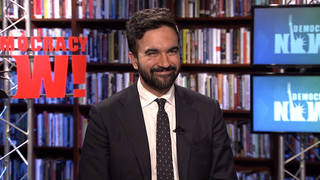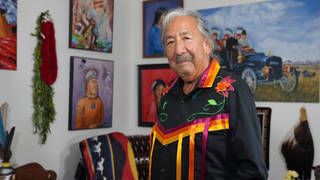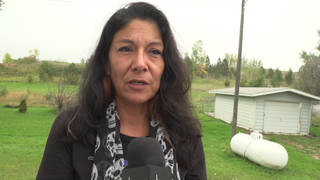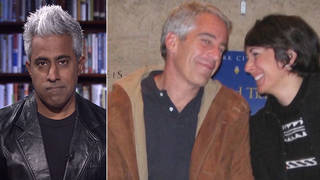
Guests
- Mike Wallaceprofessor of history at the City University of New York and chief historian for the Nueva York exhibit. He is co-author of the Pulitzer Prize-winning book Gotham: A History of New York City to 1898.
The history of Latinos in New York is the focus of a new exhibit at El Museo del Barrio in Spanish Harlem. The exhibition looks at the relationship between New York City and the Spanish-speaking world from 1613 to the end of World War II. We speak with Mike Wallace, a professor of history at the City University of New York and chief historian for the Nueva York exhibit. Mike Wallace is co-author of the Pulitzer Prize-winning book Gotham: A History of New York City to 1898. [includes rush transcript]
Transcript
AMY GOODMAN: The history of Latinos in New York is the focus of a new exhibit at El Museo del Barrio in Spanish Harlem. The exhibition looks at the relationship between New York City and the Spanish-speaking world from 1613 to the end of World War II. To accompany the exhibit, the award-winning filmmaker Ric Burns has directed a short documentary called Nueva York. The film begins with an interview with our very own Juan Gonzalez.
JUAN GONZALEZ: Well, I think the great Irish migrations in the 1840s and the Italians in the late 1800s and the early 1900s into New York, that was a migration of twenty, thirty, forty years. The Latino migration, especially into New York City, beginning with Puerto Ricans, is going to continue to the end of this century. It’s going to be a migration probably of 150 years, in terms of length. People don’t even really grasp yet, I don’t think, the enormous demographic transformation that’s occurring, but it’s entirely possible that the entire United States, by the end of this century, the majority of the people will trace their origin to Latin America. So you’re seeing, basically, the total demographic transformation of the nation. And in many ways, the Puerto Rican migration into New York was the sign of what was to come and what has continued to occur, not just in New York, but throughout the country.
AMY GOODMAN: An excerpt from the documentary Nueva York by Ric Burns, and that again was Juan Gonzalez, co-host of Democracy Now!
Joining us now, Mike Wallace, professor of history at City University of New York, worked as a chief historian for the Nueva York exhibit at El Museo del Barrio. Mike Wallace is co-author of the Pulitzer Prize-winning book Gotham: A History of New York City to 1898.
Talk about the significance of this exhibit and what you’re trying to capture.
MIKE WALLACE: Usually, the history of New York City, and to some extent of the United States, is told as an east-west phenomena. It looks at Europe, it looks at Africa, and it looks at the North American continent. People know that there is this other story in the south, but it’s peripheral. You see it out of the corner of your eye. What we try to do in this exhibit is to turn the angle of attention ninety degrees and to privilege the relations with the Spanish-speaking world. And when you do that, you discover that there’s a whole other narrative. It’s not that it’s more or less important than the east-west, but it’s a critical supplement to it. So, the whole city, and the whole country to some degree, looks different when you understand that story.
JUAN GONZALEZ: And I was fascinated, Mike, when I finally got a chance to see the exhibition that you’ve been talking to me about for years and working on, is the richness of that early Latino influence in New York —
MIKE WALLACE: Mm-hmm.
JUAN GONZALEZ: — going back to —- you came across the documents for Jan Rodrigues, who was the -—
MIKE WALLACE: Yes, there was a Jan Rodrigues, who was called by the Dutch a mulatto from Santo Domingo, and he was set ashore in 1613 and spent a year there basically trading with the Lenni Lenape and, in effect, became the first settler of non-indigenous background.
JUAN GONZALEZ: In what is now New York.
MIKE WALLACE: In what is now New York, in Manhattan, it seems to be the case, yeah.
JUAN GONZALEZ: But then you trace also the enormous importance of Latin America in the prosperity and the development and the trade of New York, as well.
MIKE WALLACE: The remarkable thing is that, on the one hand, there were virtually no Spanish people in New York for the first 150 years. This was a Dutch colony. The Dutch hated the Spanish. They hated Catholics. They didn’t want them in town. English take over; it’s the same deal for another hundred years. But at the same time, the Dutch and the English are deeply involved with the Spanish-speaking world: partly trade — they’re supplying the slaves to the Spanish Empire — and partly war — they’re fighting them all the time and stealing their treasure ships and all the rest of it. So it’s only with the Revolution, when the United States becomes independent of the British Empire, and with the wars of liberation of Spanish America, which are being — now having their bicentennial celebrations, that a connection is made between them.
And a tremendous amount of commerce begins to flow, critically around sugar, which is the other story. We usually think of cotton as the key, you know, force of the nineteenth century. And so, New York ships go down to Cuba, to Puerto Rico, still in the Spanish Empire. They go to Mexico. They go to South America. They bring back commodities that are processed here. New York becomes the biggest sugar refining operation in the country. Manufacturers are spurred to sell down to Latin America. Spanish-speaking books are printed here. Spanish currency is printed here. You know, so there’s a tremendous flow back and forth. And the money that comes out of the sugar trade goes into other things. So Moses Taylor, one of the richest merchants in the sugar trade, becomes the president of City Bank, which is the ancestor of today’s Citicorp. And then the money from the sugar trade flows in to transportation, infrastructure and the rest of it.
And those same connections that are struck, in fact, they’re the kind of metaphorical bridges across which now Spanish people begin to come. So, the two first communities in New York are, critically, Cubans, on the one hand, and Spaniards from Spain, on the other hand. The latter are agents of Spanish merchant shipping. The Cubans are Cuban planters and Cuban merchants.
But in that wave, starting in the 1810s and the 1820s, come rebels against the empire, because in fact Cuba and Puerto Rico are still inside the empire. And New York becomes a staging ground for a whole series, throughout the rest of the century, of assaults or efforts to buy or, you know, somehow to incorporate Cuba in the United States or to liberate it. And in the early days, in fact, they make their peace with slavery. I mean, the reason that Cuba and Puerto Rico are so rich and prosperous for sugar is because in fact they keep slavery, when Haiti had the revolution, and the English gave up slavery. So, the early years, they want to in fact support slavery, because in fact their profits are tied to that. By the 1880s and 1890s, when José Martí comes to town — and his base are the cigar makers and cigar rollers in New York City — there’s a dramatic shift towards complete independence. And the Spanish-Cuban-American war, which is launched from New York City and largely backed by the press and business elements in New York City, is largely run out of New York. And in 1898, New York sees itself now as the potential center of a new Latin American empire.
AMY GOODMAN: We’re talking to Mike Wallace, and he really has curated this exhibit at El Museo del Barrio. Now, you look at before 1945.
MIKE WALLACE: Right.
AMY GOODMAN: Ric Burns’s film looks post-’45. But I want to go to another excerpt from Ric Burns’s Nueva York. This is Robert Courtney Smith, author of the book Mexican New York.
ROBERT COURTNEY SMITH: We’re back now to having this very cosmopolitan city. You’re getting tremendous demographic change. In 1980, there were about 40,000 Mexicans in New York City; today there are about half a million. So, in the space of thirty years, you’ve gone more than tenfold, you know, in terms of an increase. In grammar schools here, you’ve got 50, 60, 70 percent Latino, in some of them, most of them, Mexican, half undocumented. You have booming businesses all over the place, immigrant businesses that were not here ten years ago.
AMY GOODMAN: That was an excerpt of Nueva York. Juan?
JUAN GONZALEZ: Well, Mike, talk a little bit about the decision to do the film in addition to take account of the post-1945 period, which is actually what most Americans regard as the Latino presence in the city, and the decision to include the film as part of the overall exhibition.
MIKE WALLACE: Most Americans, in general, and most Latinos, as well. It’s been remarkable, the number of people who are packing into the exhibition who are from one or another of those countries, who simply don’t know the pre-Second [World] War history. I would personally have much preferred to run the story on down ‘til now, but the level of complexity, the number of countries that are involved after 1945 is, or is not — this is something we’re going to discuss this evening — not just a quantitative change, but a qualitative change. And it wasn’t possible to do all of it. And the stuff before 1945 is what’s least known and is our particular contribution. So, on the other hand, we wanted something as a connecting link. So Ric signed on to do a film that basically picked up the story and, in a very abbreviated form, told what happened from ’45 on down ’til now.
AMY GOODMAN: I wanted to go to Ray Suarez in Ric Burns’s documentary Nueva York. This is a clip.
RAY SUAREZ: All those old boundaries between norteño and Mexican pop and salsa and reggaeton, all those boundaries are being smashed because the axis of cultural power is swinging away from San Juan and Miami and Rio and Mexico City and toward the north, where the United States is going to take its place as one of the largest Spanish-speaking countries on earth and create its own art and create its own fusion of people who are growing up in America of Latin American origin, who carry both with them into their creative expression. All those old cultural categories are being swept away by the power of numbers, by the power of commerce, by the power of attraction. It’s an enormous new idea, a pan-Latin idea.
AMY GOODMAN: That was Ray Suarez, senior correspondent for the PBS NewsHour, from the documentary Nueva York. And Juan Gonzalez is also a real main feature of this film. Let’s go to one of those clips.
JUAN GONZALEZ: Part of the problem for Americans to understand this huge migration chain is to understand what propelled the people to come. Both Puerto Ricans, who were US citizens, but also the Mexicans and the Ecuadorians and the Dominicans who came after them, every one of those countries had major problems, very often as a result of our own government’s policies there. And several of them faced years of the most brutal kind of dictatorships that were supported by the United States — Trujillo in the Dominican Republic, the Somozas in Nicaragua, Batista in Cuba. All of these were allies of the United States, all of them repressed their countries, and all of them basically were pliant supporters of the needs of American business in their countries. As a result, the economies of all these countries were distorted, and so much of the wealth of the countries left the country, left and came here, so that the migrants then were basically forced to leave. They had no choice, if they were going to survive, but to leave their country. And the easiest place to leave to, because of all the economic ties, the transportation and communication that had already been established, was the United States.
AMY GOODMAN: An excerpt of the documentary Nueva York by Ric Burns. That’s Juan Gonzalez, who’s featured in the film. The effect of Latinos shaping New York, Mike Wallace?
MIKE WALLACE: Well, there are many aspects of this, but one of the things that we feature in the exhibition is the whole cultural interrelationship. New Yorkers pride themselves on things without quite considering the antecedents. So, arguably, one of the most important contributions to world art is the New York school of abstract expressionists, but most people do not know that Jackson Pollock in 1934 was taking courses with Siqueiros on 14th Street, and they were in fact pouring Duco paint on canvases laid out on the floor. The musical interconnections you saw a bit there are enormous, and they range from the tango and Gardel, who was making movies in New York City and was an international star, to the arrival from, critically, Cuba of the whole series of musicians, who construct here rumba and mambo and the rest. And eventually, in fact, New York becomes a place that takes those arriving artists and mixes them with local artists, the mass communication industry, popular culture, and salsa in fact is the product of that. People now think it comes from anywhere, nowhere, but in fact it’s a New York phenomenon, the interplay between those worlds.
JUAN GONZALEZ: And, of course, Arthur Schaumburg —
MIKE WALLACE: Yes.
JUAN GONZALEZ: —- the father of African American studies, very few African Americans know that he was a Puerto Rican -—
MIKE WALLACE: Absolutely.
JUAN GONZALEZ: — and an advocate of autonomy and independence against Spain before he arrived here.
MIKE WALLACE: Absolutely. He was a compadre of Martí.
JUAN GONZALEZ: Right.
AMY GOODMAN: Well, you two are going to continue this discussion tonight at the CUNY Grad Center, which is over at 34th and Fifth Avenue.
MIKE WALLACE: Yes, indeed.
AMY GOODMAN: You’ll be joined by Maria Hinojosa and — who else?
MIKE WALLACE: Well, several of the advisers who worked on the exhibition. And what we’re going to kick around is the relationship, precisely, between the 350 years that we focus on in the exhibit and the post-1945 period. Was one an acorn and the other the tree, or were things so different in the contemporary world that there’s a cut there?
AMY GOODMAN: Well, Mike Wallace, we’re going to leave it there, co-author of Gotham and the curator at — the historian for the new exhibit at the El Museo del Barrio, which is around 104th and Fifth Avenue, and you can go up and see the exhibit there.












Media Options